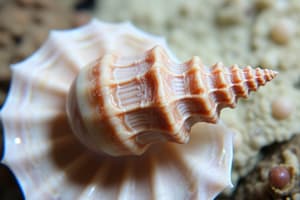Podcast
Questions and Answers
What does phylum Mollusca mean?
What does phylum Mollusca mean?
soft body
How many species of mollusks are there?
How many species of mollusks are there?
100,000 species
What is the common name for mollusks?
What is the common name for mollusks?
shellfish
What is the basic body plan of mollusks divided into?
What is the basic body plan of mollusks divided into?
What part of the basic body plan contains the mouth and sensory organs?
What part of the basic body plan contains the mouth and sensory organs?
What part of the basic body plan is used for movement?
What part of the basic body plan is used for movement?
What does the visceral mass contain?
What does the visceral mass contain?
What is the mantle in mollusks?
What is the mantle in mollusks?
How are mollusks classified?
How are mollusks classified?
What are the three classes of mollusks?
What are the three classes of mollusks?
What is the common feature of class Bivalvia?
What is the common feature of class Bivalvia?
What is a defining trait of class Gastropoda?
What is a defining trait of class Gastropoda?
What is the distinctive feature of class Cephalopoda?
What is the distinctive feature of class Cephalopoda?
What are two main characteristics that make mollusks complex?
What are two main characteristics that make mollusks complex?
How do terrestrial snails and slugs feed?
How do terrestrial snails and slugs feed?
How do terrestrial mollusks exchange gases?
How do terrestrial mollusks exchange gases?
How do aquatic mollusks like clams feed?
How do aquatic mollusks like clams feed?
How do aquatic mollusks exchange gases?
How do aquatic mollusks exchange gases?
What defines a one-way, two-opening digestive tract?
What defines a one-way, two-opening digestive tract?
What is an open circulatory system?
What is an open circulatory system?
What is a closed circulatory system?
What is a closed circulatory system?
Where does the excretion of solid waste come from?
Where does the excretion of solid waste come from?
How is cellular waste excreted in mollusks?
How is cellular waste excreted in mollusks?
Which animals are hermaphrodites?
Which animals are hermaphrodites?
What is a clam's response to stimuli?
What is a clam's response to stimuli?
What is a scallop's response to stimuli?
What is a scallop's response to stimuli?
What is an octopus' response to stimuli?
What is an octopus' response to stimuli?
How do snails move?
How do snails move?
How do clams move?
How do clams move?
How do oysters move?
How do oysters move?
How do squid and octopus move?
How do squid and octopus move?
Flashcards are hidden until you start studying
Study Notes
Phylum Mollusca Overview
- Phylum Mollusca translates to "soft body," referring to their unique anatomical structure.
- Home to approximately 100,000 species, making it one of the largest animal phyla.
- Commonly referred to as "shellfish," though this term can also include crustaceans.
Body Plan
- Mollusks have a basic body plan divided into four major parts:
- Head: Contains the mouth and sensory organs.
- Foot: Specialized for movement and varies across different classes.
- Visceral Mass: Houses the internal organs.
- Mantle: A protective tissue layer that secretes calcium carbonate to form shells.
Classification of Mollusks
- Mollusks are classified by the type of foot and shell they possess.
- Three primary classes:
- Bivalvia: Known as "two shells," exemplified by clams, oysters, mussels, and scallops.
- Gastropoda: termed "stomach foot," includes snails and slugs, some of which lack shells.
- Cephalopoda: referred to as "head foot," includes octopuses, squids, and nautiluses.
Digestive and Circulatory Systems
- Possess complex organs and organ systems with a one-way, two-opening digestive tract, indicating food moves in one direction.
- Open Circulatory System: Characteristic of slower-moving species like clams, oysters, and snails.
- Closed Circulatory System: Found in faster organisms such as octopuses and squids.
Feeding Mechanisms
- Terrestrial Feeding: Snails and slugs utilize a radula to scrape food.
- Aquatic Feeding: Clams, oysters, and scallops are filter feeders utilizing gills to extract food from water.
Respiration
- Terrestrial mollusks exchange gases through diffusion for O2 and CO2.
- Aquatic species use gills to facilitate gas exchange, ensuring efficient respiration.
Reproductive Strategies
- Snails and slugs exhibit hermaphroditic characteristics, possessing both male and female reproductive organs.
Responses to Stimuli
- Various mollusks react differently to stimuli:
- Clams burrow into sand or mud.
- Scallops employ a quick swimming response.
- Octopuses can swim rapidly, release ink, or camouflage.
Locomotion
- Snails glide using their stomach foot.
- Clams utilize a hatchet foot for burrowing movements.
- Oysters and squids employ jet propulsion for movement.
Studying That Suits You
Use AI to generate personalized quizzes and flashcards to suit your learning preferences.




